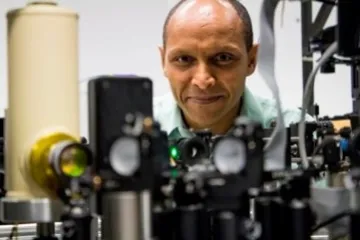When
Presenter:
Dr. Terefe Habteyes
Professor, Department of Chemistry and Chemical Biology, University of New Mexico
Abstract:
This presentation summarizes our recent findings in the areas of infrared chemical nanoimaging, molecular optomechanics and plasmon enhanced photocatalysis. Using scattering-type scanning near-field optical microscopy (s-SNOM) for nanoscale chemical imaging, we have revealed unprecedented level of structural details in a solid film of colloidal nanocrystals with organic surface ligand (e.g. trisodium citrate). It is found that the vibrational band that was thought previously to originate from surface-molecule interaction is due to relatively thick aggregates of trisodium citrate, while the interaction to the surface is mediated with hydrated sodium cation as implied from complementary surface-enhanced Raman scattering (SERS) spectroscopy. Vibrational bands corresponding to surface and subsurface intermolecular interactions are identified, and sub-wavenumber resolved imaging of the water-bending mode has revealed the existence of at least four different environments of hydrogen bonding within the trisodium citrate film. Most recent s-SNOM results on hierarchical self-assembly of carbon dots into large aspect ratio nanorowires may be presented. Molecular optomechanics in plasmonic nanocavities is manifested in laser-plasmon detuning dependent plasmon resonance linewidth broadening, indicating energy transfer from the plasmon field to collective vibrational modes, which is surprising considering the resonance mismatch. This has been demonstrated by placing layer-by-layer assembled polyelectrolytes in a rod-on-mirror (RoM) plasmonic nanocavities. The linewidth broadening accompanied by large enhancement of Raman scattering signal is observed as the laser-plasmon blue-detuning approaches the CH vibrational frequency of the molecular systems integrated in the RoM nanocavities. Our results on plasmon enhanced photochemistry will be summarized with particular emphasis on the role of surface ligands and surface-molecule charge transfer.
Biosketch:

Dr. Habteyes received his B.S. and M.S. degrees in Chemistry (minor in Physics and Math) from Addis Ababa University in 1997 and 2000, and his Ph.D. in Chemistry from the University of Arizona in 2008 working with Prof. Andrei Sanov. He was a postdoctoral fellow at the University of California at Berkeley and Lawrence Berkeley National Laboratory from 2008 to 2012 working with Prof. Stephen Leone and Prof. Paul Alivisatos.
He started his assistant professor position at the University of New Mexico in August 2012. He was promoted to associate professor with tenure in July 2018, and to full professor in July 2023. His research interest includes near-field microscopy, light-matter interactions in plasmonic nanocavities, photochemistry and surface enhanced spectroscopy
Hosted By:
Dr. Andrei Sanov






